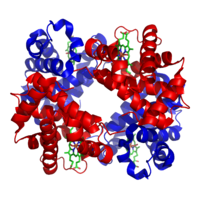
Photo from wikipedia
Molecular dynamics was used to optimize the droperidol-hERG complex obtained from docking. To accommodate the inhibitor, residues T623, S624, V625, G648, Y652, and F656 did not move significantly during the… Click to show full abstract
Molecular dynamics was used to optimize the droperidol-hERG complex obtained from docking. To accommodate the inhibitor, residues T623, S624, V625, G648, Y652, and F656 did not move significantly during the simulation, while F627 moved significantly. Binding sites in cryo-EM structures and in structures obtained from molecular dynamics simulations were characterized using solvent mapping and Atlas ligands, which were negative images of the binding site, were generated. Atlas ligands were found to be useful for identifying human ether-á-go-go-related potassium channel (hERG) inhibitors by aligning compounds to them or by guiding the docking of compounds in the binding site. A molecular dynamics optimized structure of hERG led to improved predictions using either compound alignment to the Atlas ligand or docking. The structure was also found to be suitable to define a strategy for lowering inhibition based on the proposed binding mode of compounds in the channel.
Journal Title: Chemical research in toxicology
Year Published: 2022
Link to full text (if available)
Share on Social Media: Sign Up to like & get
recommendations!